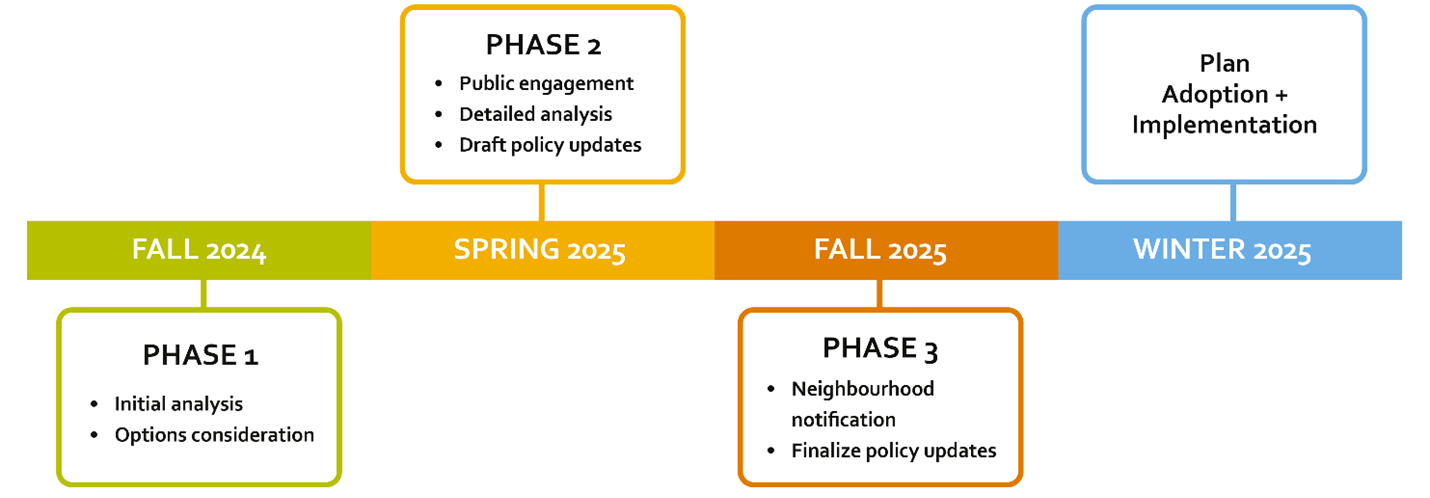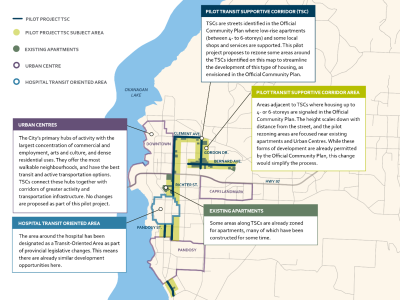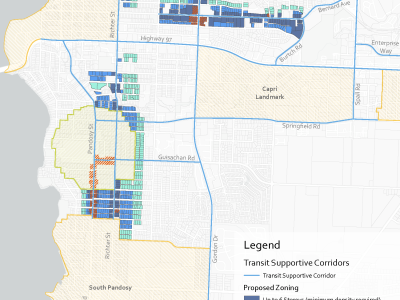Optimized transit service and transportation system
Update: Bylaw amendments headed to Public Hearing
The TSC Plan was presented on Nov. 24 and Council forwarded the related bylaw amendments to a January 2026 Public Hearing for final consideration.
The Transit Supportive Corridor (TSC) Pilot aims to establish a forward-thinking way to integrate housing and the transit system in Kelowna, one of Canada's fastest-growing cities. The draft TSC Pilot Plan outlines the City’s vision for Transit Supportive Corridors, which are strategically designated streets prioritizing increased housing density, mixed land uses, and enhanced transit services.
Further below, you can:
- 🔎 Review project background to learn more about the TSC Pilot Plan
- 📍View maps of the TSC Pilot area and proposed zoning
The draft Plan was presented to Council in August 2025. Letters were sent directly to owners and occupants of properties within the pilot area, who were invited to provide comment on what was being proposed. The comment period took place from September to October.
🔎Project background
What's proposed in the TSC Pilot Plan
In 2023, the City of Kelowna received up to $31.5M from the federal Housing Accelerator Fund (HAF) to increase housing supply to meet local needs. Growth is being prioritized along major transportation routes to align with Provincial rules, improve transit service/transportation options, make use of existing infrastructure and manage infrastructure spending, and protect the natural environment from development pressure.
Why pre-zoning?
The HAF requires the City of Kelowna to permit approximately 7,000 new housing units by October 2026. Currently, properties along TSCs are not zoned according to their land use in the OCP and have to rezone on a case-by-case basis, adding time and uncertainty to projects. This slows down the delivery of much-needed homes in our community and can make new housing more expensive.
Pre-zoning:
Benefits of Transit Supportive Corridors
Combining more housing and services along TSCs with transportation investments can have widespread economic, environmental, and social benefits, including:
-
-
Enhanced public realm and better streets
-
Better local access to daily needs
-
Increased development certainty
Project timeline + next steps
The project is in the final review stages, and public input will help inform refinements to the draft amendments before they are finalized. Council is expected to consider adoption of the Transit Supportive Corridor Pilot Plan this fall.

Public hearing process
Refined amendments were presented to Council for consideration In November 2025 and will proceed to public hearing where residents can again weigh in on what is being proposed.
What to expect if the plan is adopted
If the TSC Pilot Plan is approved by Council, the City will track and evaluate how the new pre-zoning approach works in this area over time. The City will look at things like the number of new homes built, improvements to transportation, and community feedback. What is learned from this pilot will help decide if and how pre-zoning could be used in other areas of the city in the future.
📍TSC Pilot area maps
Area Map - Click to enlarge
Zoning Map - Click to enlarge
❔Question & answer
Prezoning & the Transit Supportive Corridor Pilot Plan
Right now, zoning (rules that determine what you’re allowed to build on a specific property) doesn’t match what’s outlined for Transit Supportive Corridors in the Official Community Plan (OCP). The TSC pilot plan proposes changing zoning for Transit Corridors to match the OCP, making it easier to build homes up to 4 or 6 storeys along busy streets where people use transit.
If someone wants to build something new today, they currently have to go through a process to change the zoning for each property. This can slow things down and make homes cost more.
Pre-zoning makes it easier and faster for people to build homes where it makes the most sense. This helps us get the homes we need more quickly and can make them more affordable. It also gives everyone—builders, neighbours, and the City—more certainty about what’s coming.
Kelowna needs more homes for people, and the City wants to make it easier to build them in places where people can walk, bike, and use public transit. This plan makes the process simpler and less uncertain for everyone, helps keep homes affordable, and brings improvements to neighbourhoods while staying true to the City’s long-term vision and ensuring alignment with provincial rules and federal initiatives.
Your neighbourhood
Things are still expected to change slowly over many years and new homes will be built gradually, just like today. If the TSC Pilot Plan is approved, property owners can choose if and when they want to redevelop, and nothing happens unless they decide to build something new.
Over time, you might see more housing, better sidewalks and bike paths, improved bus service, and more shops nearby. Any improvements would happen gradually, and you can find more details in the Draft Plan.
Kelowna needs thousands of new homes to help people find places to live, keep homes affordable, and reduce homelessness. Focusing on busy streets where people use transit brings benefits like better transportation, more shops and services, and makes it easier to plan infrastructure upgrades. The streets selected for the TSC Pilot are already designated as Transit Corridors in the OCP.
Impacts to property owners
No new costs are being introduced by the TSC Pilot. If you want to build something new, the usual charges, like Development Cost Charges, would apply.
Zoning changes do not automatically change your property value, and zoning is just one of many factors that contribute to how BC Assessment determines value. For more information, please visit: How BC Assessment Works
No, you don’t have to do anything because of this plan. There are no new requirements for residents or property owners in the area. If you have questions, you can always contact the City.
Building and redevelopment
Yes, you can build less than the maximum number of storeys and there is no minimum height requirement.
Transportation and infrastructure
Through many years of public engagement that shaped the OCP, and subsequent Citizens Surveys, the City has heard that people want new homes in core neighbourhoods to be supported by enhanced transit service, walking and cycling connections. The Draft Plan includes improvements to walking, biking, and bus service over time. These changes will happen in the short term and long term. For more details, see page 33 of the Draft Plan.
Yes, as new buildings go up, you can expect upgrades like better sidewalks, new bike lanes, more shops close to home, and improved public spaces. These changes will make it easier for residents to get around, socialize and have more of their daily needs met closer to home.
Leave your questions here.
To ask a question you must create an account or log in.
These are the people that are listening and responding to your questions.
Arlene Janousek
Planner
{{question.description}}






